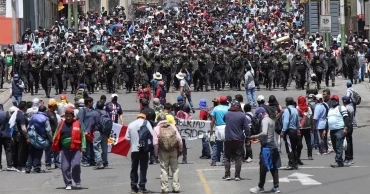Peru
Peru's Congress votes to oust the interior minister for failing to halt killings
Peru's Congress voted Friday to remove the interior minister from office after deciding that he had failed to adequately handle rising violent crime in the Andean country.
Interior Minister Juan José Santiváñez by law has 72 hours to leave his position after the no-confidence vote, which succeeded with 78 votes in favor, 11 against and 20 abstentions. Santiváñez insisted that he had worked hard alongside police during his 10 months in office, but that he would respect the lawmakers' decision.
Santiváñez must step down and take responsibility for his “inability to address the wave of citizen insecurity the country is facing,” the Peruvian Congress said on its X account.
Public outrage has surged over an increase in killings and other violence, especially the killing Sunday of Paul Flores, the 39-year-old lead singer of the cumbia band Armonia 10. He was fatally shot when assailants attacked his band's tour bus after a concert in Lima.
Fire at London's Heathrow Airport leaves thousands of travelers in trouble
In reaction to the Flores killing, President Dina Boluarte on Monday declared a state of emergency in the capital and ordered the deployment of soldiers to help police address the surge of violence. That same day, opposition lawmakers requested a vote of no confidence against the interior minister.
Boluarte’s government previously had decreed a state of emergency from September to December in an attempt to stem the violence.
Authorities reported 2,057 killings in 2024, up from 1,506 in 2023.
9 months ago
10 Most Earthquake-prone Countries around the World
In recent years, several earthquakes have devastated different parts of the globe. Earthquakes are caused by sudden movement along tectonic plates within the surface of earth. These movements release energy in the form of seismic waves that cause the earth's surface to shake. These geological events disrupt lives and economies, standing as stark reminders of the need for earthquake preparedness. Let's take a look at the top earthquake-prone countries across the world and understand their vulnerabilities.
The World's 10 Most Earthquake-prone Countries
Japan
Japan occupies a precarious position in the Pacific Ring of Fire, an arc characterized by fault lines and volcanic activity in the Pacific Ocean basin. This is the convergence of four tectonic plates: the Pacific, Philippine, Okhotsk, and Eurasian.
The primary reason behind Japan's seismic vulnerability is the collision and subduction of these tectonic slabs. The Pacific Plate is subducting beneath the North American Plate, creating deep ocean trenches and mountain ranges.
Read more Earthquake Safety Tips for Parents to Keep Children Safe
The 2011 Tohoku earthquake, with a magnitude of 9.1, triggered a devastating tsunami, claiming around 19,759 lives. The 2016 Kumamoto earthquake, measuring magnitude 7, caused about 273 fatalities.
2 years ago
From a secret safehouse, Peru's Indigenous revolt advances
In an industrial corridor of Peru's capital, a dingy stairwell leads to a second-floor safehouse. Dozens of Quechua and Aymara activists lie on mattresses strewn on the floor, resting up for more anti-government demonstrations as volunteers cook a breakfast of donated rice, pasta and vegetables.
Among the makeshift refuge's occupants is Marcelo Fonseca. The 46-year-old watched as a a friend was shot and killed in December as they battled security forces in the southern city of Juliaca. Within hours, Fonseca joined a caravan of demonstrators that descended on the capital, Lima, to demand the resignation of interim President Dina Boluarte.
“Our Andean blood burns when we become furious,” Fonseca, whose native language is Quechua, said in a halting Spanish. ”It runs faster. That’s what brings us here.”
Two months into Peru’s angry insurrection, emotions have hardened. While the unrest has barely disturbed the late-night revelry in Lima's beachside enclaves, roadblocks still rage across the countryside, scaring away foreign tourists and leading to shortages of gas and other staples.
The tumult, which has left at least 60 dead, was triggered by the impeachment in December of President Pedro Castillo. To Peruvians like Fonseca, the leftist rural teacher was a symbol of their own exclusion, while Boluarte's ascension to power from the vice presidency in cahoots with Castillo's conservative enemies in Congress is seen as an unforgivable class betrayal.
The impasse has given a jolt of self-confidence to Peru's Indigenous movement. Unlike neighboring Bolivia, where Indigenous groups were emboldened by Aymara coca-grower Evo Morales' election as president in 2006, or Ecuador, where ethnic groups have a long tradition of toppling unpopular governments, Peru's Indigenous groups had long struggled to gain political influence.
Although Peruvians of all backgrounds take pride in the history of the Inca Empire, the country's Indigenous population is often treated with neglect and even hostility. Little is done to promote Quechua, despite its being spoken by millions and being an official language since 1975. Not until the 2017 census were Peruvians even asked whether they identify with any one of 50-plus Indigenous groups.
Tarcila Rivera, a prominent Quechua activist and former adviser to the United Nations on Indigenous issues, attributes the disdain to systemic racism stretching back to the Spanish conquest.
“Despite the two hundred years since the founding of our republic, the reality is that those of us who come from pre-Hispanic civilizations haven't obtained our rights, nor are those rights taken into account,” said Rivera.
The current turmoil has also unleashed a torrent of racism. One lawmaker from the floor of Congress disparaged the rainbow-colored Wiphala flag, which represents the native people of the Andes, as little more than a “chifa tablecloth,” using the word for a cheap Chinese restaurant. Another urged security forces to send protesters to Bolivia with a big “kick.”
Rivera says the crackdown has radicalized younger protesters. Meanwhile, the spread of smartphones and the Internet during the past few decades of economic stability has made Indigenous Peruvians more aware of their rights, the country's gaping inequalities and the sacrifices of previously unheralded Indigenous heroes, whose achievements contrast with narratives of perennial victimhood.
“All our kids are ever been taught is that we're losers, miserable souls who were conquered without a fight," Rivera said.
The current protest movement is centered in the southern Andes, where Indigenous identity is strongest. The area is the source of much of Peru's mineral wealth and is home to archeological jewels that attracted more than 4 million tourists a year before COVID.
Its peasants are also among Peru's most neglected.
Those inequalities were on vivid display this month at a roadblock near Cusco, where a group of campesinos sat vigil for hours over a roadblock of tires, tree trunks and boulders. As the line of stranded vehicles grew, tensions flared as motorists complaining that they had family emergencies.
“Don't yell at me when I'm speaking to you with manners!” barked one motorist who faulted the protestors for voting for Castillo, who lived in an adobe home in one of Peru's poorest districts before winning the presidency. “Don't let shameless politicians, who are often from the same community, trick you," he said repeating a false narrative held by elites that Castillo's victory was the result of bribes, fraud and chicanery.
Eventually, the demonstrators yielded to the pressure and briefly opened the road, after a harangue against the “millionaires" and powerful interests blamed for driving their community to desperate actions.
Back in Lima, the safehouse is a hive of activity as another day of demonstrating awaits. Hand-written signs list daily chores to keep the cramped quarters safe and clean. Dozens more activists from Cusco are expected soon and need to be lodged in one of the few dozen homes, apartments and businesses across the capital that have opened their doors, like clandestine rebel bases.
Discretion is a must. Like Fonseca, many of the demonstrators were already detained when security forces firing tear gas last month stormed a university campus at breakfast and arrested hundreds for trespassing. As a result, occupants are encouraged to leave the safehouse one or two at a time, turn off lights early and immediately report any police intrusion to two human-rights attorneys on permanent standby. The windows are covered with newspapers and dog-food bags to block out would-be snoops.
But more than fear, the mood is one of hope.
“No matter what happens, I dare say we've already won,” said Victor Quinones as he stuffs a wad of coca leaves into his cheek.
At 60, Quinones is one of the group's veterans. He says the past few weeks in the capital have strengthened his resolve to push forward and no longer accept the status quo — or futile standoffs with police back home as the best way to change it.
“We broke the barrier. We've started our long march — and look at all this support we've garnered along the way," he reflects. "We've won because, now, the world knows.”
2 years ago
Steady rains set off mudslides that kill at least 36 in Peru
Landslides triggered by steady rains swept mud, water and rocks into several villages in southern Peru, killing at least 36 people, authorities said Monday.
Wilson Gutierrez, a civil defense official in the Mariano Nicolás Valcárcel municipality in Camana province, told local radio RPP that 36 bodies had been recovered in a remote sector called Miski.
Among the dead were five people who were riding in a van that was pushed into a river by a surge of mud.
Local officials appealed for heavy machinery to be sent in to clear debris blocking three kilometers (nearly two miles) of an important road.
Civil defense officials said an estimated 630 homes were unusable after the landslides, which also hit bridges, irrigation canals and roads.
Constant rains are frequent in February in Peru and often cause deadly landslides.
2 years ago
Peru anti-government protests spread, with clashes in Cusco
Protests against Peruvian President Dina Boluarte’s government that have left 47 people dead since they began a month ago spread through the south of the Andean country on Wednesday with new clashes reported in the tourist city of Cusco.
Health officials in Cusco said 16 civilians and six police officers were injured after protesters tried to take over the city’s airport, where many foreign tourists arrive to see sites including the nearby Incan citadel of Machu Picchu.
Protests and road blockades against Boluarte and in support of ousted President Pedro Castillo were also seen in 41 provinces, mainly in Peru’s south.
Read more: Policeman burned to death amid antigovernment unrest in Peru
The unrest began in early December following the destitution and arrest of Castillo, Peru’s first president of humble, rural roots, following his widely condemned attempt to dissolve Congress and head off his own impeachment.
The protest, mainly in neglected rural areas of the country still loyal to Castillo, are seeking immediate elections, Boluarte’s resignation, Castillo’s release and justice for the protesters killed in clashes with police.
Some of the worst protest violence came on Monday when 17 people were killed in clashes with police in the city Juliaca near Lake Titicaca and protesters later attacked and burned a police officer to death.
In total, Peru’s Ombudsman’s Office said that 39 civilians have been killed in clashes with police and another seven died in traffic accidents related to road blockades, as well as the fallen police officer.
Peru’s government has announced a three-day curfew from 8 p.m. to 4 a.m. in Puno.
The National Prosecutor’s Office said it has requested information from the Presidency of the Council of Ministers and the defense and interior ministries for an investigation it has opened against Boluarte and other officials for the protest deaths.
In Juliaca, in Puno province, a crowd marched alongside the coffins of the 17 people killed in Monday’s protests.
“Dina killed me with bullets,” said a piece of paper attached to the coffin of Eberth Mamani Arqui, in a reference to Peru’s current president.
“This democracy is no longer a democracy,” chanted the relatives of the victims.
As they passed a police station, which was guarded by dozens of officers, the marchers yelled: “Murderers!”
Meanwhile, a delegation from the Inter-American Commission on Human Rights began a visit to Peru on to look into the protests and the police response.
Boluarte was Castillo’s former running mate before taking over the presidency. She has said she supports a plan to push up to 2024 elections for president and congress originally scheduled for 2026. She’s also expressed support for judicial investigations into whether security forces acted with excessive force.
But such moves have so far failed to quell the unrest, which after a short respite around the Christmas and New Year’s holidays have resumed with force in some of Peru’s poorest areas.
Castillo, a political novice who lived in a two-story adobe home in the Andean highlands before moving to the presidential palace, eked out a narrow victory in elections in 2021 that rocked Peru’s political establishment and laid bare the deep divisions between residents of the capital, Lima, and the long-neglected countryside.
2 years ago
13 killed in Peru clashes amid new anti-government protests
At least 13 people died Monday in southeast Peru as protests seeking immediate elections resumed in neglected rural areas of the country still loyal to ousted President Pedro Castillo.
Peru's top human rights agency called for an investigation into the deaths, 12 of which took place amid clashes between security forces and protesters attempting to seize control of an airport in the city of Juliaca, near the border with Bolivia.
It was the highest death toll since the unrest began in early December following Castillo's removal and arrest following a widely condemned attempt to dissolve Congress and head off his own impeachment. Among the 12 killed in Juliaca was a 17-year old, according to news reports. A 13th person died in the nearby city of Chucuito, where protesters blocked a highway.
Castillo's successor, his former running mate Dina Boluarte, has supported a plan to push up to 2024 elections for president and congress originally scheduled for 2026. She's also expressed support for judicial investigations into whether security forces acted with excessive force.
But such moves have so far failed to quell the unrest, which after a short respite around the Christmas and New Year's holidays have resumed with force in some of Peru's poorest areas, where support for Castillo's unorthodox rule had been strongest.
Nationwide, protests were reported in about 13% of Peru's provinces on Monday, many of them consisting of roadblocks making it impossible for truckers to deliver produce to market.
With Monday's casualties, the number of people killed in clashes with security forces climbed to 34. Hundreds more have been treated for injuries.
Boluarte's government has accused former Bolivian President Evo Morales of fueling the unrest. On Monday, officials issued an order blocking the influential leftist leader from entering the country on national security grounds. Authorities said eight allies of Morales — who were also banned — recently traveled to Peru to coordinate protest activity in the border region separating the two countries.
Castillo, a political novice who lived in a two-story adobe home in the Andean highlands before moving to the presidential palace, eked out a narrow victory in elections last year that rocked Peru’s political establishment and laid bare the deep divisions between residents of the vibrant capital, Lima, and the long-neglected countryside.
2 years ago
Peru Congress to reconsider early election, unrest continues
Peru's Congress is set Tuesday to consider holding early elections, beset by protesters who have blocked highways and clashed with security forces amid deadly nationwide unrest ever since the lawmakers ousted President Pedro Castillo.
It's the second time in days that the lawmakers — easily the most reviled of a widely discredited political elite — are taking up the proposal to push forward to next year the elections for president and Congress originally planned for 2026.
The measure has the backing of caretaker President Dina Boluarte, who took over from Castillo after the former rural school teacher tried to dissolve Congress on Dec. 7 — a move widely condemned by even his leftist supporters as a self-coup and act of political suicide. After the failed move, he was swiftly arrested.
Read more: Peru judge orders 18-month detention for ousted president
The early elections proposal failed to muster enough votes last week after leftist lawmakers abstained, conditioning their support on the promise of a constitutional assembly to overhaul Peru's political charter — something that conservatives denounce as putting Peru's free market economic model at risk.
“Don’t be blind,” Boluarte said in comments over the weekend, slamming lawmakers for not moving more decisively to defuse mounting political tensions. “Look at the people and take action in line with what they are asking.”
Castillo, a political novice who lived in a two-story adobe home in the Andean highlands before moving to the presidential palace, eked out a narrow victory in elections last year that rocked Peru's political establishment and laid bare the deep divisions between residents of the vibrant capital, Lima, and the long-neglected countryside.
Castillo's attempts to break a stalemate with hostile lawmakers by closing Congress only deepened those tensions. Within hours of his attempted power grab, he was ousted by Congress and jailed facing a criminal investigation, accused of trying to usurp power in violation of the constitution.
Read more: Anger in rural areas fuel protests against Peru government
Boluarte, who has the backing of U.S. President Joe Biden's administration and speaks fluently the native Quechua language of many protesters, has struggled to restore order in the restive nation.
In several parts of the country, protesters who voted for her and Castillo's ticket last year have defied a 30-day state of emergency and taken to the streets to demand her immediate resignation.
The death toll from the unrest rose to 26 on Monday after security forces firing tear gas dispersed thousands of informal miners who cut off the Pan-American Highway at two vital chokepoints for more than a week, forcing truckers to dump spoiled food and fish bound for market. Hundreds have been injured.
Should lawmakers decide to push up elections, they would in essence be throwing themselves out of work. Under Peru's constitution, the 130 members of Congress are entitled to serve only a single term.
Boluarte is also facing pressure from fellow leftists across Latin America led by Mexican President Andrés Manuel López Obrador.
Ignoring calls by Boluarte and others to butt out of Peru's internal affairs, López Obrador has criticized Peru's conservative media and business establishment for the classist, sometimes bigoted way it portrayed Castillo during his 17-month presidency.
On Monday he said that if lawmakers reject early elections and cling to power, and the president stays, then "everything will have to be achieved by force and repression, leading to a great deal of suffering an instability for the people.”
The Mexican president has reiterated his willingness to grant asylum to Castillo, who was intercepted by protesters and security forces while trying to flee to the Mexican Embassy in Lima after his bid to shutter Congress backfired.
3 years ago
Peru judge orders 18-month detention for ousted president
A Peruvian judge on Thursday ordered ousted President Pedro Castillo to remain in custody for 18 months as nationwide protests set off by the political crisis showed no signs of abating and the death toll rose to at least 14.
The judge’s decision came a day after the government declared a police state as it struggles to calm the violence that has been particularly fierce in impoverished Andean regions that were the base of support for Castillo, a leftist former schoolteacher, himself of humble roots.
The ouster of the political neophyte whose surprise election last year brought immediate pushback from the political elite has drawn thousands of his loyal supporters to the streets.
Forty people remained hospitalized for injuries suffered during the civil unrest, according to the Ministry of Health.
The protests erupted after Castillo was removed from power by lawmakers last week, following his attempt to dissolve Congress ahead of a third impeachment vote. The crisis has only deepened the instability gripping the country, which has had six presidents in as many years.
Judge Juan Carlos Checkley Soria’s ruling came after Congress stripped Castillo of the privilege that keeps Peru’s presidents from facing criminal charges.
Castillo and his legal team refused to participate in Thursday’s virtual hearing, arguing it lacked “minimum guarantees.” He was represented by a public defender, who said the judge’s decision will be appealed.
Peru’s Supreme Prosecutor Alcides Chinchay said in court Thursday that Castillo faces at least 10 years in prison on charges of rebellion.
Meanwhile, a large group of protesters — and police in riot gear — gathered in central Lima Thursday evening. The government also imposed a roughly dusk-to-down curfew for five days in at least 15 communities, as allowed by the nationwide emergency declaration issued Wednesday.
The protesters were demanding Castillo’s freedom, the resignation of President Dina Boluarte, and the immediate scheduling of general elections to pick a new president and members of Congress. They have burned police stations, taken over an airstrip used by the armed forces and invaded the runway of the international airport in Arequipa, a gateway to some of Peru’s tourist attractions.
Thousands of tourists have been affected by the protests. The passenger train that carries visitors to Machu Picchu suspended service, and roadblocks on the Pan-American Highway stranded tractor trailers for days, spoiling food bound for the capital.
In Cusco, a top tourist destination, people were stuck Thursday at hotels and the airport.
Read more: Congress removes Peru's president amid political unrest
“I was about to return to Ecuador on Monday, and unfortunately, they told us that all flights were canceled due to the protests,” said Karen Marcillo, 28, who has had to sleep at the Teniente Alejandro Velasco Astete airport in Cusco.
The impact on tourism comes as Peru is still recovering from the effects of the pandemic, which reduced visitations last year to 400,000, down from 4.4 million in 2019.
While in office, Castillo spent much of his time defending himself against attacks from an adversarial Congress and investigations ranging from corruption to plagiarism. Now, it remains unclear whether Boluarte — once his running mate and vice president — will get a chance to govern. Just like Castillo, she is a newcomer to politics without a base in Congress.
“She’s doing a good job right now,” said Cynthia McClintock, a political science professor at George Washington University who has studied Peru extensively. “But it’s a big challenge.”
While some protesters “seem to want kind of instability at any cost,” McClintock said, others saw Castillo’s ouster as an opening to express simmering grievances, such as deep inequality, poverty and lack of public services.
Boluarte, though, may be given some breathing room by lawmakers seeking to keep their jobs. They cannot pursue re-election and would be jobless if a general election for Congress is scheduled, as protesters want.
Boluarte on Wednesday sought to placate the protesters by saying general elections could potentially be scheduled for December 2023, four months earlier than the timing she had proposed to Congress just a few days earlier.
All of the protest-related deaths have occurred in rural, impoverished communities outside Lima that are strongholds for Castillo, who himself comes from a poor Andean mountain district and had no prior political experience.
In Andahuaylas, where at least four people have died since the demonstrations began, no soldiers were on the streets Thursday despite the government declaration allowing the armed forces to help maintain public order.
Some grocery store owners there were clearing the roads littered with rocks and burned tires, but planned to close their doors because of the expected protests led by people from nearby rural communities.
Castillo’s move to dissolve Congress came as lawmakers began a third attempt to impeach him since he was elected in July 2021. After Congress voted him out of power, Castillo’s vehicle was intercepted as he traveled through Lima’s streets with his security detail.
Chinchay, the government’s top prosecutor, insisted Castillo was a flight risk, saying he was trying to reach the Mexican Embassy to seek asylum after he left the presidential palace.
“We do not believe that he wanted to go to the Mexican Embassy to have tea,” Chinchay said.
In issuing his ruling, the Judge Checkley said a “concrete flight risk” still exists and “remains latent over time. Besides Castillo’s apparent effort to reach the Mexican Embassy, he cited remarks from Mexico’s president and foreign minister regarding their country’s willingness to offer him asylum, and a jail visit he received from Mexico’s ambassador in Peru.
Read more: Anger in rural areas fuel protests against Peru government
Castillo’s public defender, Italo Díaz, rejected assertions the former president is a flight risk. He told the judge Castillo’s children and wife depend on him and he could return to his teaching job if freed.
Castillo is being held at a built-for-presidents detention center inside a National Police facility. On Thursday, police in riot gear stood outside the facility as dozens of Castillo supporters gathered throughout the day.
The state of emergency declaration suspends the rights of assembly and freedom of movement and empowers the police, supported by the military, to search people’s homes without permission or judicial order.
Defense Minister Luis Otarola Peñaranda said the declaration was agreed to by the council of ministers.
On Wednesday, Boluarte pleaded for calm as demonstrations continued against her and Congress. “Peru cannot overflow with blood,” she said.
In a handwritten letter shared Wednesday with The Associated Press by his associate, Mauro Gonzales, Castillo asked the Inter-American Commission on Human Rights to intercede for his “rights and the rights of my Peruvian brothers who cry out for justice.” The commission investigates allegations of human rights violations and litigates them in some cases.
3 years ago
Plane hits vehicle on runway, catches fire at Lima’s airport
A LATAM Airlines plane taking off from Lima’s international airport struck a firetruck on the runway and caught fire Friday. Authorities said the plane’s passengers and crew were all safe, but two firefighters in the truck were killed.
Lima Airport Partners, the company that operates Jorge Chávez International Airport, said in a tweet that operations at the facility had been suspended. There were 102 passengers and six crew members aboard the Airbus A320neo.
“Our teams are providing the necessary care to all passengers, who are in good condition,” the company said.
Luis Ponce La Jara, general commander of the fire department, said two firefighters were killed and one was injured when the truck they were in was struck by the plane. Both the plane and the firetruck were in motion when they collided.
President Pedro Castillo expressed his condolences to the families of the firefighters in a tweet.
Flight LA2213 was taking off from Lima’s main airport en route to the Peruvian city of Juliaca.
Videos on social media showed smoke coming from a large plane on the runway.
Read more: Small plane crashes into Tanzania's Lake Victoria, 19 dead
LATAM Airlines said it lamented the death of the firefighters and would provide flexibility to reprogram flights to affected passengers at no extra cost. But it said it did not know why the firetruck was on the runway. “No emergency was reported on the flight It was a flight that was in optimal conditions to take off, it had authorization to take off and it encountered a truck on the runway and we don’t know what the truck was doing there,” said Manuel van Oordt, general manager of LATAM Airlines Peru. “We have to investigate and establish why it was there.”
The Prosecutor’s Office in Callao, where the airport is located, said an investigation into the cause of the accident had been opened.
According to the fire department, the incident was registered at 3:25 p.m. and four rescue units were mobilized.
Read more: Plane crash kills 2, burns homes in California neighborhood
Aviation authorities said operations at Jorge Chávez International Airport were suspended until 1 p.m. local time Saturday. Flights would be direct to other airports in the meantime.
3 years ago
Peru extends state of emergency due to COVID-19 amid fourth wave
Peru extended a state of emergency on Thursday over the COVID-19 pandemic amid a fourth wave.
The decision extends emergency conditions for another 28 days as of Aug. 1.
"The national state of emergency will be extended due to the serious circumstances that affect the lives and health of people as a result of COVID-19," the official newspaper "El Peruano" said.
Peru remains on alert amid the new wave, seeing an average of 11,000 new cases a day last week, official figures showed.
Read: Peru faces "community transmission" of monkeypox: top health official
The Health Ministry has issued 80,336,753 vaccines, of which 68.6 percent correspond to a third dose and 17.4 percent to a fourth.
According to the World Health Organization, Peru saw 14,186 new infections and 41 deaths from the disease on Thursday, for a total of 3,873,702 cases and 214,120 deaths.
3 years ago



















